#Eric M Esquivel
Text
Tournament of Lokis: Round 1
Propaganda is welcome. Vote for your favorite Loki. You have 1 week.

TBI Loki Propaganda:
"thats it. look at her. shes haunted shes gay shes played by tim she sacrificed herself and died slowly and painfully over 80 years to give the Yggsdrasil system a chance to survive. shes so tragic and i was crying during ragnarok v"

#the bifrost incident#tbi#loki#norse mythology#ragnarok and roll#eric m. esquivel#tournament of lokis#round 1#LokiInMedia
52 notes
·
View notes
Text
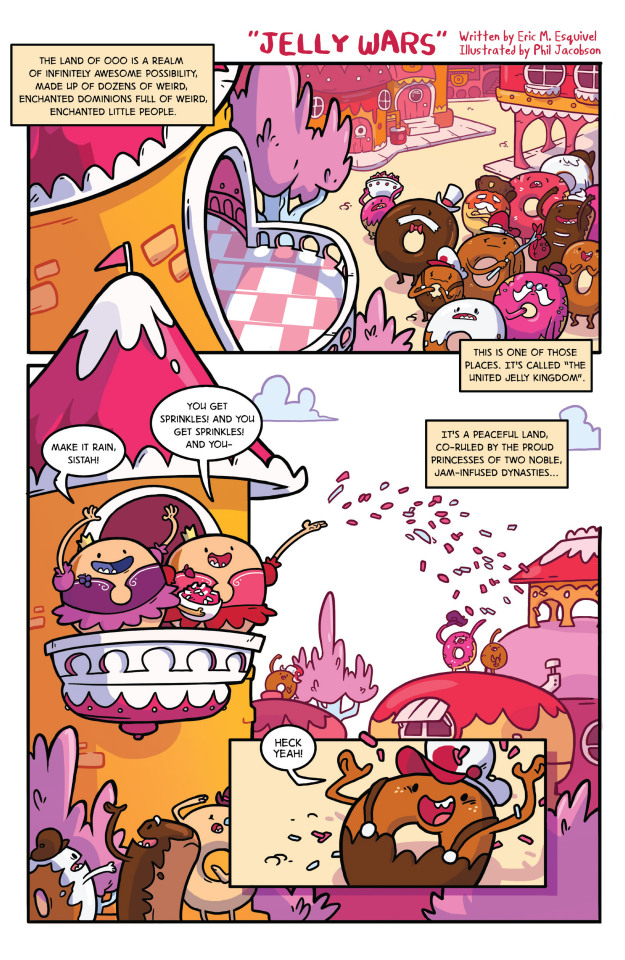
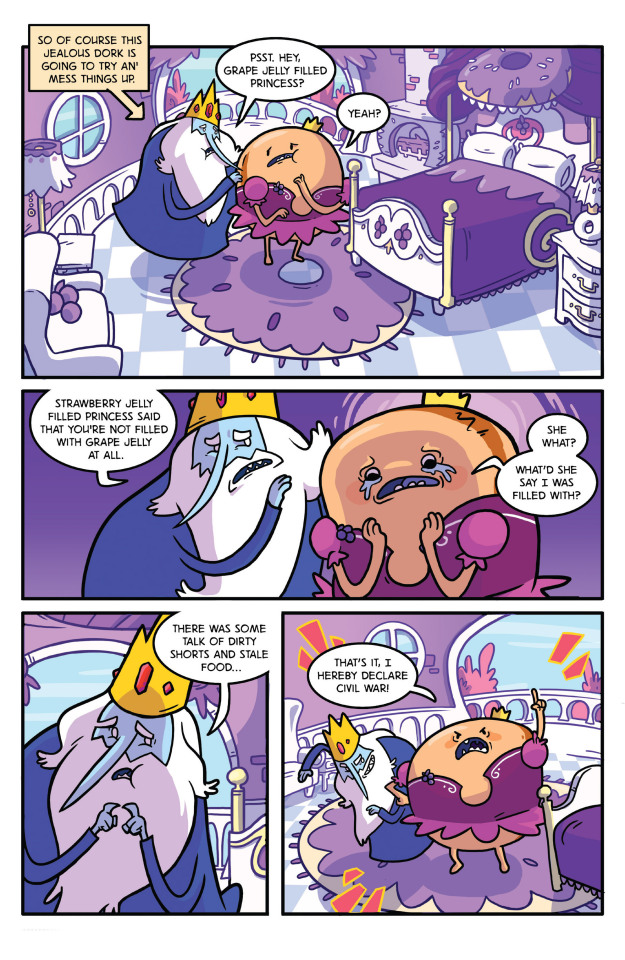


Adventure Time #27: "Jelly Wars (Part 1)"
Writer: Eric M. Esquivel
Art/Letters: Phil Jacobson
#Boom Studios#KaBoom Studios#Adventure Time#atimers#Grape Jelly Filled Princess#Strawberry Jelly Filled Princess#Ice King#Finn the Human#Jake the Dog#Eric M. Esquivel#Eric Esquivel#Phil Jacobson#2014#Archie Sonic Contributors
19 notes
·
View notes
Text
Birthdays 11.26
Beer Birthdays
Georg Schneider (1817)
Simon E. Bernheimer (1849)
Five Favorite Birthdays
Johannes Bach; German organist and composer (1604)
Eugene Ionesco; Romanian-French writer (1912)
Rich Little; comedian (1938)
Charles M. Schulz; cartoonist (1922)
Ilona "Cicciolona" Staller; Hungarian-Italian porn actor, politician (1951)
Famous Birthdays
Bob Babbitt; bass player (1937)
Garcelle Beauvais; model, actor (1966)
Natasha Bedingfield; English singer-songwriter (1981)
Elizabeth Blackburn; Australian-American biologist (1948)
Margaret Boden; English computer scientist (1936)
Willis Carrier; air-conditioning inventor (1876)
Roz Chast,; cartoonist (1954)
William Cowper; English poet (1731)
Cyril Cusack; South African-born Irish actor (1910)
Frances Dee; actress and singer (1909)
DJ Khaled; rapper (1975)
Adolfo Pérez Esquivel; Argentinian painter (1931)
Lefty Gomez; New York Yankees P (1908)
Robert Goulet; American-Canadian singer (1933)
Davey Graham; English guitarist and songwriter (1945)
Sarah Moore Grimké; author (1792)
Blake Harnage; singer-songwriter and guitarist (1988)
John Harvard; college founder (1607)
Line Horntveth; Norwegian tuba player, composer (1974)
Dave Hughes; Australian comedian (1970)
Raymond Louis Kennedy; singer-songwriter, saxophonist (1946)
Yumi Kobayashi; Japanese model, actress (1988)
Martin Lee; English singer-songwriter and guitarist (1949)
Bat Masterson; police officer and journalist (1853)
Anna Maurizio; Swiss biologist (1900)
Maurice McDonald; businessman, co-founder of McDonald's (1902)
John McVie; English-American bass player (1945)
Marian Mercer; actress and singer (1935)
Jim Mullen; Scottish guitarist (1945)
Marianne Muellerleile; actress (1948)
Michael Omartian; singer-songwriter, keyboard player (1945)
Ruth Patrick; botanist (1907)
Vicki Pettersson; author (1971)
Velupillai Prabhakaran; Sri Lankan rebel leader (1954)
Marilynne Robinson; writer (1943)
George Segal; artist, sculptor (1924)
Eric Sevareid; television journalist (1912)
Jan Stenerud; Kansas City Chiefs K (1942)
Betta St. John; actress, singer and dancer (1929)
Julien Temple; English film director (1952)
Art Themen; English saxophonist and surgeon (1939)
Tina Turner; American-Swiss rock singer (1938)
Tony Verna; director and inventor of instant replay (1933)
Mary Edwards Walker; surgeon and activist (1832)
Ellen G. White; co-founder of 7th-day Adventist Church (1827)
Norbert Wiener; mathematician (1894)
Earl Wild; pianist and composer (1915)
Bill Wilson; AA founder (1895)
Karl Ziegler; German chemist (1898)
0 notes
Text
Researchers reveal a map to study novel form of cell-to-cell communication
“Ribonucleic acid or RNA is one type of genetic material that is present inside all living cells. It is mostly known to act as a messenger carrying instructions encoded in the DNA for the synthesis of proteins,” said co-corresponding author, Dr. Aleksandar Milosavljevic, professor and Henry and Emma Meyer Chair in Molecular Genetics at Baylor. He also is the director of the Graduate Program in Quantitative & Computational Biosciences and a member of the Dan L Duncan Comprehensive Cancer Center at Baylor. The Milosavljevic Lab is the host of the exRNA Atlas, the data management and resource repository of the Extracellular RNA Communication Consortium, an NIH Common Fund project exploring the biology of exRNA.
In recent years research has shown that RNA not only exists inside cells, but also is exported from cells as extracellular RNA and plays a role in cell-to-cell communication.
“ExRNAs exist in bodily fluids outside of cells where they can associate with a variety of carriers including RNA binding proteins (RBPs), but the cargo and distribution of RBPs across biofluids is largely unknown,” said coauthor Robert Fullem, a graduate student in the Milosavljevic lab. “Our goal in this study was to fill that gap. This major gap in knowledge limited our understanding of the role of RBPs as carriers of exRNA in human bodily fluids. Our findings open a new road toward understanding exRNA biology and provide new opportunities for the development of exRBP/exRNA liquid biopsy biomarkers.”
The researchers applied computational analyses to identify exRBPs in plasma, serum, saliva, urine and cerebrospinal fluid. The computational predictions were validated experimentally at about 80% in both plasma and cell cultures in the lab, suggesting high specificity for the computational method.
“With this information, we developed a map of candidate exRBPs and their exRNA cargo in bodily fluids expanding the landscape of potential biomarkers that can now be studied in liquid biopsies and used to track normal and disease processes,” Milosavljevic said. “We present this map as a resource available at no cost to the scientific community.”
Other contributors to this work include co-first authors Emily L. LaPlante and Alessandra Stürchler, David Chen, Anne C. Starner, Emmanuel Esquivel, Eric Alsop, Andrew R. Jackson, Ionita Ghiran, Getulio Pereira, Joel Rozowsky, Justin Chang, Mark Gerstein, Roger P. Alexander, Matthew E. Roth, Jeffrey Franklin, Robert Coffey, Robert L. Raffai, Isabelle M. Mansuy, Stavros Stavrakis, Andrew deMello, Louise C. Laurent, Yi-Ting Wang, Chia-Feng Tsai, Tao Liu, Jennifer Jones, Kendall Van Keuren-Jensen and Eric Van Nostrand.
This publication was supported in part by the NIH Common Fund (1UG3TR002881-01, 1U54DA036134-01,1U54DA049098-01, 1U54DA049098-01S1, 1UH3TR002881, OT2OD030547-01S1 and 5UG3TR002881-02). Further support was provided by CPRIT Scholar in Cancer Research grants RR200040, 4UH3CA241703-03, and a Swiss National Center of Competence (NCCR) in Research RNA & Disease grant.
0 notes
Photo

Interview: Writer Eric M. Esquivel and Artist Ramon Villalobos Talk BORDER TOWN READ AT DREADCENTRAL.COM.
7 notes
·
View notes
Photo
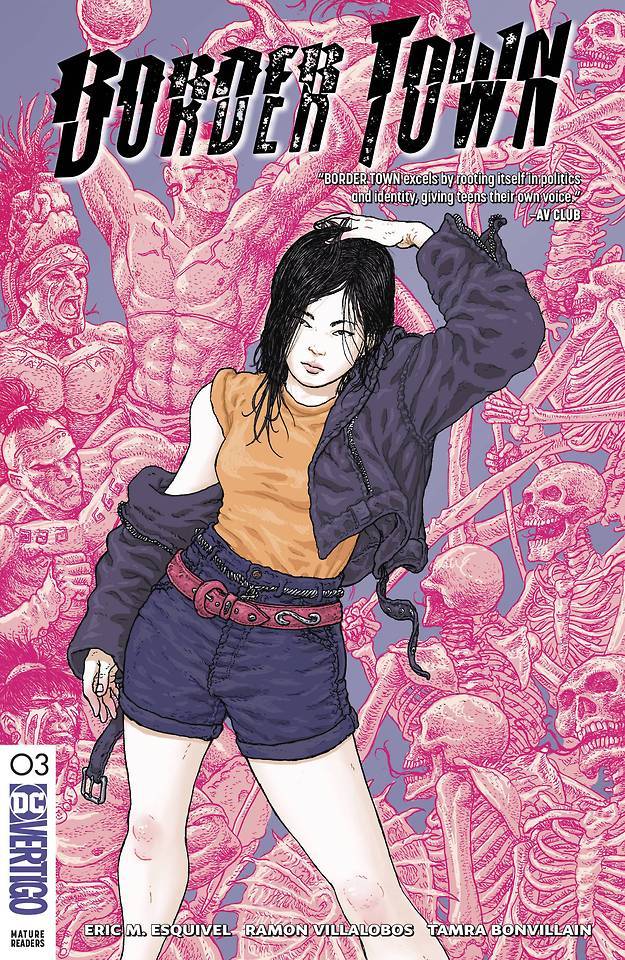
BORDER TOWN #3
Written by Eric M Esquivel
Art by Ramon Villalobos
The crazy old lady known only as La Curandera tells a tale that begins 500 years ago in the Aztec Empire at the peak of its strength and ends in her dirty little Arizona gift shop with four kids and a wayward Chupacabra, all of whom are meant to save the world from an ancient evil. Alas, it's a school night. But our heroes defy their destinies at tremendous cost when a new and yet very familiar foe is revealed.
Available at Lobo Comics & Toys this coming Wednesday, 11/07/2018
visit us on facebook, google+, blogspot, our eBay store, and our website
#border town#dc#dc comics#eric m esquivel#ramon villalobos#lobo comics and toys#lobo comics#lobo#lobo comics toys#comics#toys#comic#comic store in albuquerque#comic shop in albuquerque#albuquerque#comic shop in new mexico#comic store in new mexico#new mexico
2 notes
·
View notes
Photo

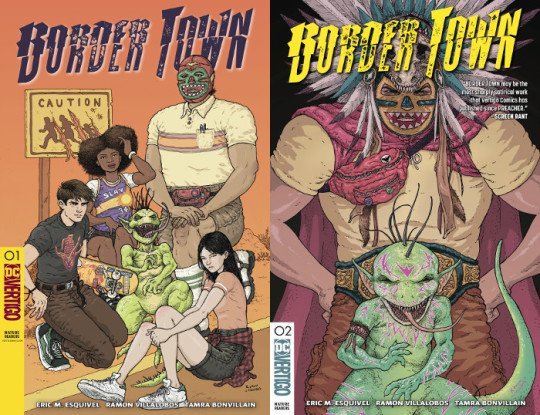
Border Town #1 & 2
“Número Uno: Bienvenidos a Hell” & “Número Dos: Máscaras”
Writer: Eric M. Esquivel | Artist: Ramon Villalobos | Colourist: Tamra Bonvillain | Letterer: Deron Bennett
Published by DC Comics / DC Vertigo | 5.9.2018 & 3.10.2018 | $3.99
The Sandman Universe titles notwithstanding, Border Town was heralded as the flagship of the new DC Vertigo relaunch and refocus. When you look at the content, it’s easy to see why, even outside of the obvious quality of the story being told.
Border Town encapsulates a lot of the verve and substance of the early Vertigo breakout projects, incorporating bits of the supernatural, mythology, humour, and the human experience in a mature and thought-provoking way.
Thematically, it’s also a series about that lurker at the threshold, the unknown just behind that liminal boundary, so it makes sense that it would serve as the doorway into the new DC Vertigo.

The first issue introduces us to one of our main point of view characters, Frank, as he and his family move to the town of Devil’s Fork, Arizona. He’s a fairly typical teenager, looking to more or less fit in, rebel against his parents, and punch white supremacists in the face. Complicating this is a bizarre little chupacabra, who is appearing as things that people fear, and eating people around town.

The second issue expands more or the mythological and folklore-based creatures residing in Mictlan, as we find out that the chupacabra from the first issue is a bit of a misfit of its own. It also gives a hint as to what’s happening to Blake since getting bit, and reforming a bit of a new Scooby Gang of Frank, Julietta, Aimi, and Quinteh even after they claimed to have gone their separate ways.

Frank is an interesting protagonist, if flawed.
Through his point of view, we get a fresh look at Devil’s Fork, a quick run down of the numerous flaws of Arizona as a state, and that fish out of water quality of moving to a new town. You get a sense from him that he is fairly progressive, but there’s a violent streak in there. Kind of conflicting natures between someone looking to conform and someone looking to rebel. In essence, a teenager trying to find his place in the world.
I find how Eric M. Esquivel is developing Quinteh more interesting. In the first issue he’s somewhat the silent, misunderstood brute archetype, with it even being pointed out, but not necessarily confirmed, that he may be developmentally disabled. The second issue makes you wonder more if it’s just anxiety, as there’s a very nice story from his mom to help him overcome stress in social situations, and no particular irregularities in his speech patterns. I also quite like the parallel between his luchador mask and the ritual headdresses from Aztec culture.
Blake, a straight edge Nazi skinhead--which seems like a bizarre combination--, is set up as the early antagonist. He’s about what you’d expect from a racist playing at being a tough guy. That when it comes down to it, he’s a coward. He is changing, though, as hinted at in the second issue and it should be interesting to see what kind of monster he becomes.
The other characters are interesting, but still need some fleshing out. They feel like real people with interesting quirks. I particularly like Frank’s mom’s boyfriend, Nick. He’s obviously set up as a foil for Frank, and someone to rebel against, to blame for Frank’s current predicament, but he’s not particularly a “bad guy” for what little he appears so far. He’s kind of obnoxious, and holds some questionable views, but he comes across as someone at least trying to support his family.
I wonder about those creatures of myth and legend in Mictlan, though. We’ve only got the main characters interacting with the chupacabra so far, it’ll be interesting to see what develops further. With Frank and the kids ducking into La Curandera’s shop, and her hinting at something bigger, I wonder if this is going to take on more of a Buffy the Vampire Slayer approach in the future. I certainly wouldn’t mind seeing further issues and arcs centring around these other beasties. La Llorona and La Lechuza have some fairly well-known transitions into English storytelling, but I’d love to see all of them developed.

The art in Border Town is incredible. Ramon Villalobos and Tamra Bonvillain are creating a unique and impressive visual array with this series, ranging from the ordinary kids to the weird supernatural creatures.
I really like Villalobos’ artwork. His style is in roughly the same school as Frank Quitely, Chris Burnham, and Martín Morazzo; highly stylized, but with an impressive range of character expression and design. The human characters are appealing and unique, especially when it comes to Quinteh and his luchador mask, but where he really shines is the supernatural aspect. The designs for the chupacabra, Mictlāntēcutli, and the other residents of Mictlan are very impressive. The variety and detail that go into the reflections of fears embodied by the chupacabra’s appearance is both humorous and interesting. I especially got a kick out of the “urban teenager” and Bane panels in the first issue.
Though using fairly normal, grounded hues for the human characters, there’s also a somewhat otherworldly glow that Bonvillain is applying to the world. The skies are often purple for night scenes and there are some very interesting choices for pinks, greens, and blues in backgrounds and in the characters that make it feel just slightly unnatural. It manages to enhance the overall feel of the story, making you feel something’s just a little bit off. This effect becomes even more pronounced in Mictlan when even stranger colours come to the fore.
Deron Bennett’s lettering is also quite nice. Particularly what I’d call the “Halloween font” for Mictlāntēcutli’s dialogue. It’s hilariously over the top and perfectly fits the grandstanding for the character.

There are a couple of problems, however, that arise in the book.
The first is the use of language. In the first issue, Quinteh is referred to with a slur used against the developmentally disabled. On Twitter, Esquivel has responded that it’s uttered by the “bad guy”, and that it is meant to portray Quinteh’s regular experience, which in itself is valid, but it still normalizes the ablest insult. It doesn’t matter if it’s being uttered by an antagonist or villain, it still uses the term in a negative and derogatory fashion.
Similarly, in both first and second issues, “pussy” is used to mean coward. In both cases, they’re spoken by a protagonist, so it can’t even be relegated to a bad act by a “bad guy”. This one is a bit more nebulous than the first since etymologically “pussy” in this regard isn’t problematic, however, most people don’t know the diminution of pusillanimous. Instead, they conflate it with a euphemism for female genitalia. Despite not logically making any sense to call a coward a vagina, it’s still perpetuates that meaning to many.
Which ties into the second potential problem of an undercurrent of toxic masculinity bleeding into the work. It’s very clear that some of the worst of it is an exhibited trait from the various antagonists in the series, like Blake, Frank’s mom’s boyfriend (though I don’t necessarily think of him as a “bad guy”, just not necessarily the brightest bulb and in the beginning a foil for Frank’s social unrest), the MAGA idiots at the beginning of the first issue, but it’s also exhibited by Frank himself.
Like with the use of “pussy” as an insult, Frank glorifies violence, and follows through with an assault on Blake. While this could certainly be considered justifiable given Blake’s attitude, and could be interpreted as a pleasing thing to the audience seeing it as a racist’s comeuppance, it’s undermined a bit by Frank’s further insult of Blake’s group being “White Powerpuff Girls”. While it is a clever pun, it further reinforces that idea of women or girls being an insult.
Given the care that Esquivel takes in the first issue to delineate how one should take pride in all of their ethnic heritage in their speech, not breaking it down by percentages like a “Half-Mexican”, it seems weird that this kind of machismo would be present. Maybe it’s intentional. Maybe it’s as is alluded to in the second issue another “mask”, another tough guy act that will be addressed, but all of this can be off-putting to some. I’d give Esquivel the benefit of the doubt for this being something to be addressed further in to the story.

Overall, I quite like this.
The story so far is a nice mix of relevant social issues and supernatural adventures that reminds me a bit of an updated Buffy, but with a more irreverent sense of humour and pulling some of the kids’ problems to the forefront. It’s less about the supernatural right now, more about the coming-of-age aspect, though I feel like that’s going to slightly change. I do wonder how I’d feel about Frank being a “chosen one”.
And the art is fantastic. The storytelling from Villalobos and Bonvillain just makes the book come together. The characters, designs, and action elevate the book incredibly.
I’d recommend this to people who like a bit of humour with their horror, like Buffy the Vampire Slayer, Wynonna Earp, or even something like Jim Butcher’s The Dresden Files. Lapsed early Vertigo readers should also find something to like in Esquivel and Villalobos’ use of mythology and folklore to help explore the human condition.

Extra: There is a nice panel with a number of Easter eggs that ties together some Vertigo and DC mainstays. The most obvious being Dream’s mask, Doctor Occult’s talisman, a variation on Doctor Fate’s helmet, a poster of Constantine and Zatanna, Wonder Woman as a Virgin Mary stature, a Black Mercy plant, and more if you want to point out some of the other things on display. It’s a nice homage to what’s come before and places Border Town in the wider context of the DC/Vertigo history.

d. emerson eddy has a copy of the Lurker at the Threshold. It doesn’t have anything to do with this, but just wanted to mention HP Lovecraft. Who, despite being problematic in his racism and misogyny, still wrote some pretty great horror. Even if that one apparently is mostly August Derleth.
2 notes
·
View notes
Photo

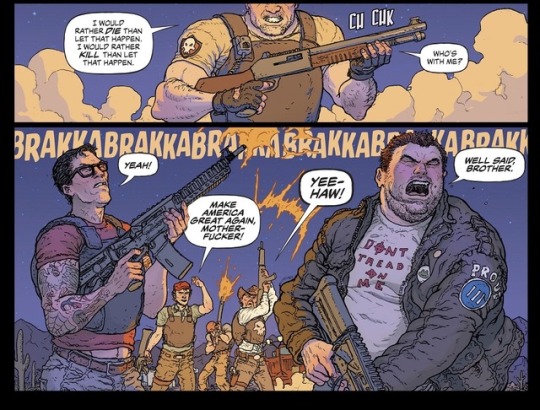

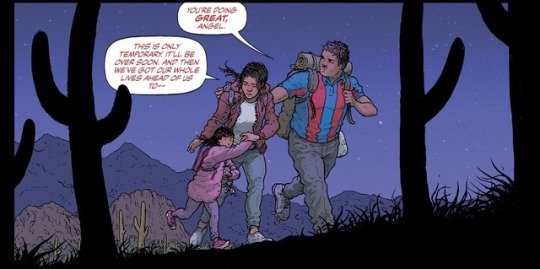
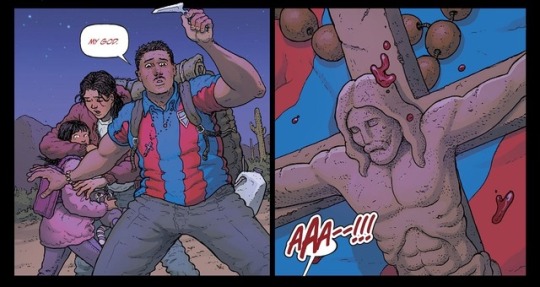
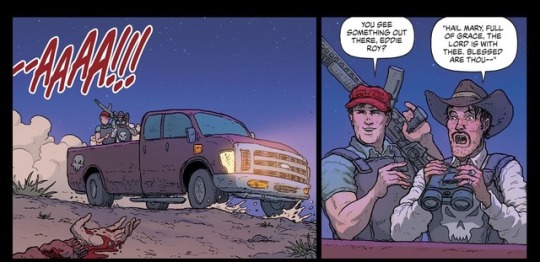
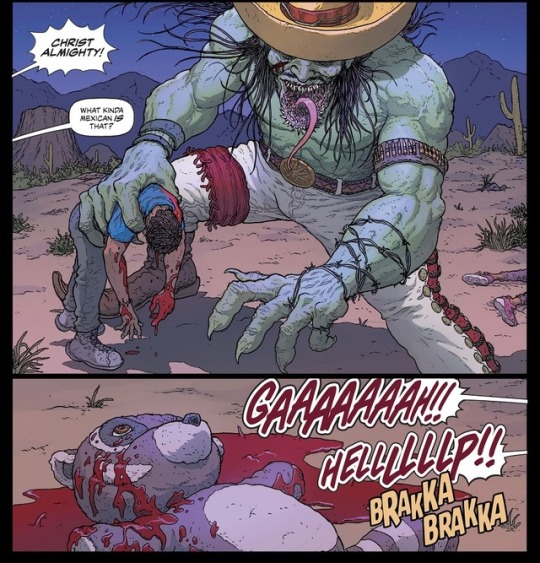


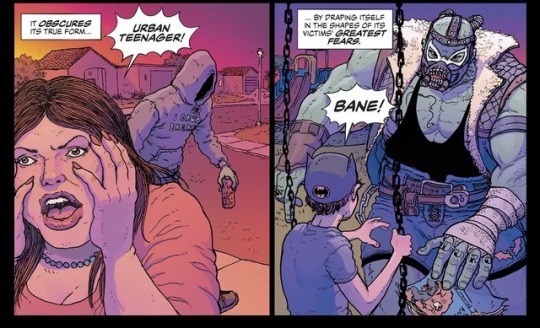
Border Town #1 (2018)
Eric M. Esquivel
Ramon Villalobos
Tamra Bonvillain
Deron Bennett
3 notes
·
View notes
Photo

Interview: Writer Eric M. Esquivel and Artist Ramon Villalobos Talk BORDER TOWN READ AT DREADCENTRAL.COM.
1 note
·
View note
Text
Myth!Loki's Hair Color: Common Depictions
Because the AI user that just annoyed me also claimed myth!Loki's canonical hair color is blonde and that's why they did that crappy blonde MCU!Loki AI art, and I am feeling spiteful cus fuck AI and that eyesore, and I need to wash that off my brain.
AND I KNOW this claim came from those people that interact with THAT ONE VERY obnoxious Sigyn stan that pretends to be a Norse mythology expert despite never providing proper citations or citing modern myth re-tellings and whines about children's story books not being accurate. Ask her to cite her claims and actually look at the sources, for the love of Loki!
LOKI HAS NO KNOWN HAIR COLOR IN THE MYTHS! THERE's NO SOURCE FOR THAT! Loki's also a shape-shifter! Loki can have their hair look like whatever the fuck they want. To my knowledge, the only gods that have confirmed hair colors are myth!Thor, who is said to a red-head, and myth!Sif being a blonde who gets a wig of magical gold to substitute her chorn hair. There's also a description of myth!Heimdall who is said to be the "whitest" god, implying blonde/white hair? Loki's only mentioned to be pretty, assumed to be Aesir -sized rather than gigantic, likely smaller than myth!Thor because myth!Thor can kick his ass and he can hold onto Thor's belt when crossing a river (Skáldskaparmál), and have scars on his lips due to them being sown shut.

Also from Gylfanning: "Loki is beautiful and comely to look upon, evil in spirit., very fickle in habit. He surpassed other men in that wisdom which is called 'sleight,' and had artifices for all occasions; he would ever bring the Æsir into great hardships, and then get them out with crafty counsel."
There's also the Snaptun stone, believed to be Loki due to the scarred lips, giving him a mustache.
The most common and widespread hair color depictions of Loki have red/ginger/orangey hair due to Loki mistakenly being thought to associated with fire because their name's too similar to the fire personification Jotun's name, Logi, because Richard Wagner fucked up in his Ring Cycle Operas and combined the two of them into "Loge". Arthur Rackham's illustrations based on Wagner's Ring Cycle are possibly the most influential in that regard because they're fucking awesome. Even GOW made their Loki depiction a red-head.
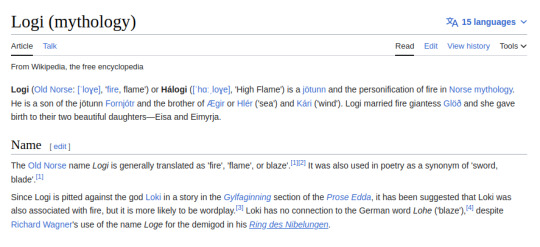
And here's a painting that looks like a ginger to me by James Doyle Penrose (1912):
The second most common hair color depiction is black hair, probably thanks to Marvel as it's most prevalent in modern depictions (e.g. Alan Cumming's Loki in "Son of the Mask", whom I fucking love).
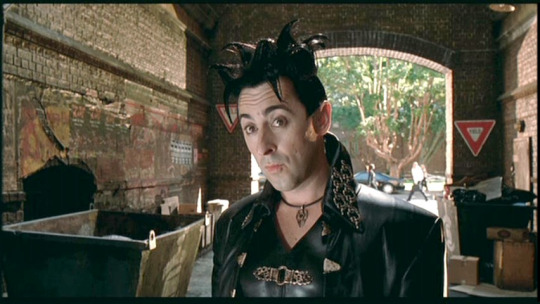
There's also the Valhalla comics that started in 1979 (after Marvel, but I don't think that contributed AT ALL because Vallhala comics are way more myth-accurate and fucking awesome. I am just including it here because it's a black-haired Loki depiction).
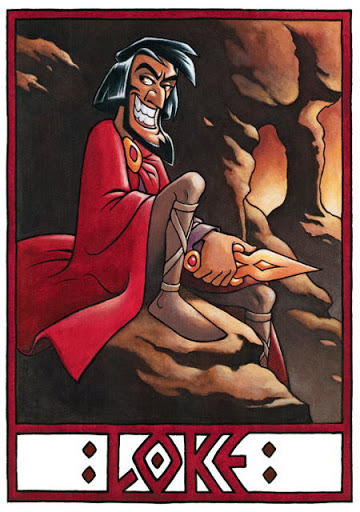
There's also Eric M. Esquivel's Ragnarok n' Roll (have not read and I am not inclined to do so, but it kept showing up in my loki searches 10+ years ago and its existence was archived in my brain due to that). Is it me or does he looks like Cantinflas because of the mustache?

This is Cantinflas btw

There's also Jul I Valhall Loke (Thanks Scandinavian Twitter users for showing me this gem even if I can't understand the language. I am forever grateful.)
youtube
And surprisingly, Marvel was not the first to give him black hair. Marten Eskil Winge portrayed Loki with black hair in his 1863 painting "Loki and Sigyn."
Neil Gaiman has depicted Loki with a variety of hair colors, USUALLY as a literally "fiery" red-head (Sandman comics & American Gods book), whatever Johnathan Tucker's hair color is in the American Gods TV show, and black-haired (Norse Mythology graphic novel).



There's a brown-haired Loki depiction in Assassin's Creed (I have not played it btw).

And sometimes he's just some demonic thing with horns:

#i have a weird belief myth!loki's hair is brown because no one comments on it#myth!loki#norse mythology#valhalla comics#the life and times of juniper lee#neil gaiman#american gods#arthur rackham#richard wagner#son of the mask#alan cummings#marten eskil winge#sandman#assasin's creed#marvel comics#mcu#jul i valhal#james doyle penrose#peter madsen#eric m. esquivel#idw comics#atreus#god of war#LokiInMedia#IStartShit#hot takes#Youtube
12 notes
·
View notes
Photo
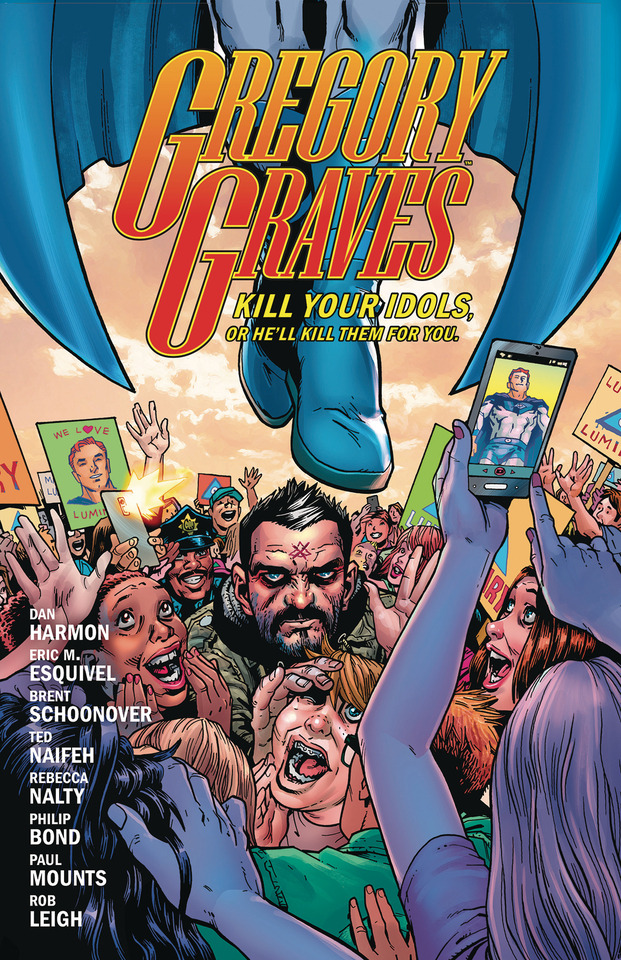
“Gregory Graves Volume 1: Interview with a Supervillain” (W)Dan Harmon, Eric M Esquivel (A) Brent Schoonover, Ted Naifeh
The world sighs in relief that insane scientist, Gregory Graves, is behind bars, awaiting execution. Granting a final interview, Graves tells his side of the story in a world where so-called “heroes” with the power to snuff out the sun ask us to trust their pinky-promise that they won’t. But when the secret of Earth’s mightiest hero comes out, Graves might not look so crazy anymore. Written by Rick and Morty and Community creator, Dan Harmon, along with DC comics writer, Eric Esquivel, “Gregory Graves” Volume 1 will be available July 18, 2018 $6.99
1 note
·
View note
Video
youtube
Davey and Jimmy talk about their favorite bass players, fan art, Calabrese Comic Books and their interest in outer-space – you asked, Davey and Jimmy answered!
►Subscribe: http://www.smarturl.it/CalabreseYoutube
#Calabrese#davey calabrese#Jimmy Calabrese#sean yseult#cliff burton#gene simmons#peter steele#dee dee ramone#nim vind#Andrew Barr#eric m esquivel#comic books#aliens#askcalabrese#rob blasko
5 notes
·
View notes
Text
Birthdays 11.26
Beer Birthdays
Georg Schneider (1817)
Simon E. Bernheimer (1849)
Five Favorite Birthdays
Eugene Ionesco; Romanian-French writer (1912)
Rich Little; comedian (1938)
Charles M. Schulz; cartoonist (1922)
Ilona "Cicciolona" Staller; Hungarian-Italian porn actor, politician (1951)
Tina Turner; American-Swiss rock singer (1938)
Famous Birthdays
Bob Babbitt; bass player (1937)
Johannes Bach; German organist and composer (1604)
Garcelle Beauvais; model, actor (1966)
Natasha Bedingfield; English singer-songwriter (1981)
Elizabeth Blackburn; Australian-American biologist (1948)
Margaret Boden; English computer scientist (1936)
Willis Carrier; air-conditioning inventor (1876)
Roz Chast,; cartoonist (1954)
William Cowper; English poet (1731)
Cyril Cusack; South African-born Irish actor (1910)
Frances Dee; actress and singer (1909)
DJ Khaled; rapper (1975)
Adolfo Pérez Esquivel; Argentinian painter (1931)
Lefty Gomez; New York Yankees P (1908)
Robert Goulet; American-Canadian singer (1933)
Davey Graham; English guitarist and songwriter (1945)
Sarah Moore Grimké; author (1792)
Blake Harnage; singer-songwriter and guitarist (1988)
John Harvard; college founder (1607)
Line Horntveth; Norwegian tuba player, composer (1974)
Dave Hughes; Australian comedian (1970)
Raymond Louis Kennedy; singer-songwriter, saxophonist (1946)
Yumi Kobayashi; Japanese model, actress (1988)
Martin Lee; English singer-songwriter and guitarist (1949)
Bat Masterson; police officer and journalist (1853)
Anna Maurizio; Swiss biologist (1900)
Maurice McDonald; businessman, co-founder of McDonald's (1902)
John McVie; English-American bass player (1945)
Marian Mercer; actress and singer (1935)
Jim Mullen; Scottish guitarist (1945)
Marianne Muellerleile; actress (1948)
Michael Omartian; singer-songwriter, keyboard player (1945)
Ruth Patrick; botanist (1907)
Vicki Pettersson; author (1971)
Velupillai Prabhakaran; Sri Lankan rebel leader (1954)
Marilynne Robinson; writer (1943)
George Segal; artist, sculptor (1924)
Eric Sevareid; television journalist (1912)
Jan Stenerud; Kansas City Chiefs K (1942)
Betta St. John; actress, singer and dancer (1929)
Julien Temple; English film director (1952)
Art Themen; English saxophonist and surgeon (1939)
Tony Verna; director and inventor of instant replay (1933)
Mary Edwards Walker; surgeon and activist (1832)
Ellen G. White; co-founder of 7th-day Adventist Church (1827)
Norbert Wiener; mathematician (1894)
Earl Wild; pianist and composer (1915)
Bill Wilson; AA founder (1895)
Karl Ziegler; German chemist (1898)
0 notes
Text
My therapist also agreed with me what DC did to Poison Ivy is also rather horrible, as well as this mess they’ve made of Nightwing with Lobdell and Esquivel which is equally disgusting
Just keep that in mind when you see people defending Heroes In Crisis.
#dc comics#heroes in crisis#poison ivy#pamela isley#pamela lillian isley#nightwing#dick grayson#robin#titans#teen titans#tom king#scott lobdell#eric m. esquivel#eric esquivel
33 notes
·
View notes
Photo

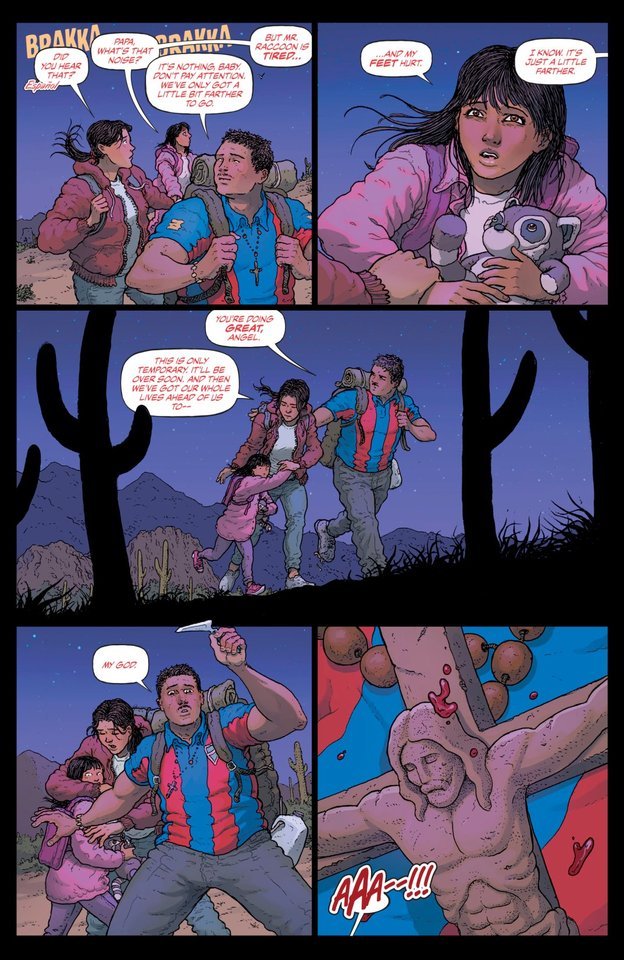
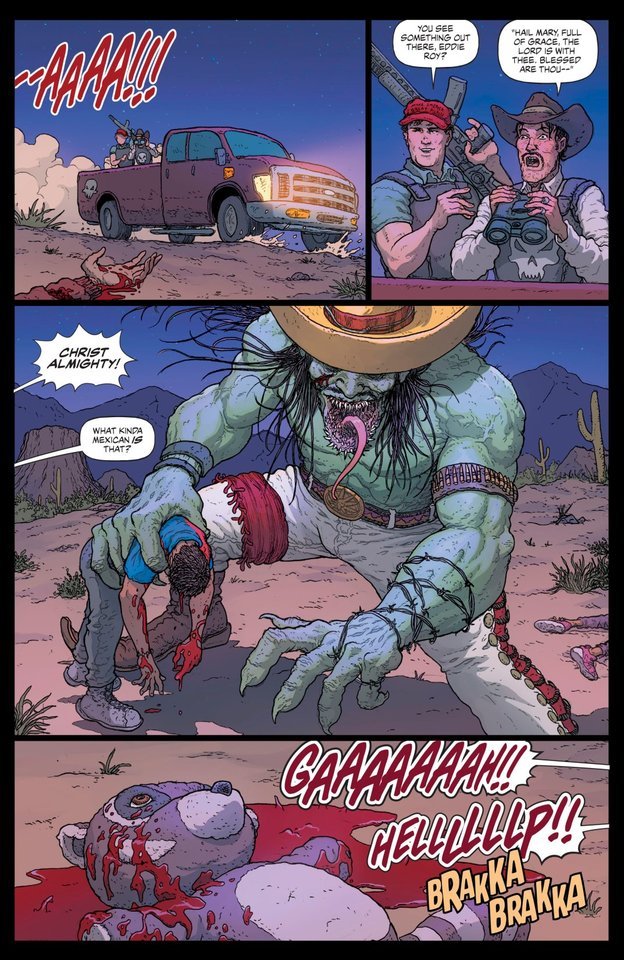

When a crack in the border between worlds releases an army of monsters from Mexican folklore, it’s up to a motley crew of high school misfits to discover what’s really going on!
#comiXology#Vertigo Comics#Border Town#Eric M. Esquivel#Ramon Villalobos#Tamra Bonvillain#digital com#ncbd
64 notes
·
View notes
